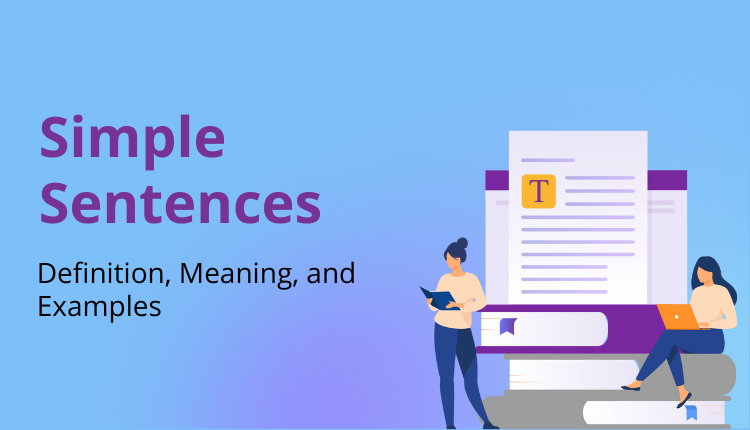Introduction
Good communication starts with comprehension of the basic building blocks of language. One of the easiest and most fundamental sentence forms is the simple sentence. Whether you are a student, a career writer, or an individual simply wishing to improve your communication skills, it is important to master simple sentences. Here we will examine the meaning, use, and examples of simple sentences, as well as a comparison to other types of sentences.
What Is a Simple Sentence?
A simple sentence is a sentence that has just one independent clause. That is, it will have a subject and a predicate, making up a complete thought. A simple sentence will not have any subordinate or dependent clauses, unlike compound or complex sentences.
Definition of a Simple Sentence
A simple sentence is an elementary sentence structure that carries a whole idea with fewer elements. It usually has a subject (who or what the sentence is referring to) and a predicate (what the subject is doing or what is done to the subject).
Example:
- She runs every morning.
- The cat sleeps on the mat.
Both of these sentences have a subject (She, the cat) and a verb (runs, sleeps), hence simple sentences.
Understanding Simple Sentences
Simple sentences are the foundation of language. They convey complete thoughts with clarity and precision. A simple sentence has a subject and a predicate, so that readers can quickly understand meaning.
Simple sentence understanding is crucial for good communication. They are used to pass across ideas without complexity. Writers can make their writing style better and readers follow their message seamlessly by mastering this structure. Simple sentences provide rhythm in writing and keep the audience engaged throughout a given work.
Principal Features of Simple Sentences
- Has a single independent clause
- Represents a complete idea
- Has a minimum of one subject and one verb
- May include modifiers but no dependent clauses
Example:
- John reads books. (Subject: John, Verb: reads)
- The sun rises in the east. (Subject: The sun, Verb: rises)
How to Build a Simple Sentence
Building a simple sentence is easy. Here’s how:
- Identify the Subject: The person, place, thing, or idea the sentence is about.
- Pick a Verb: The action or state of being.
- Make Sure It Creates a Complete Thought: A simple sentence has to stand on its own and make sense.
- Avoid Adding Dependent Clauses: Keep the structure simple and clear.
Examples of Well-Formed Simple Sentences
- Dogs bark.
- She enjoys reading.
- The baby cried loudly.
Simple Sentences vs. Other Sentence Structures
Comprehension of the difference between simple sentences and other types of sentence structures can help enhance writing and communication skills.
Simple Sentences vs. Compound Sentences
A compound sentence is a combination of two or more independent clauses combined with a coordinating conjunction (i.e., and, but, or).
Example:
- Simple: I like coffee.
- Compound: I enjoy coffee, and I have it every morning.
Simple Sentences vs. Complex Sentences
A complex sentence has one independent clause and one or more dependent clauses.
Example:
- Simple: She went home.
- Complex: She went home because she was ill.
Simple Sentences vs. Compound-Complex Sentences
A compound-complex sentence includes at least two independent clauses and one or more dependent clauses.
Example:
- Simple: The dog barked.
- Compound-Complex: The dog barked when the doorbell rang, and the cat fled.
Examples of Simple Sentences
To solidify your knowledge, here are additional examples of simple sentences:
- Birds fly.
- The teacher teaches the lesson.
- He enjoys playing soccer.
- They went to the museum.
- The flowers bloom in spring.
Improve Writing with Trinka Grammar Checker
Enhancing your writing is easy with the Trinka Grammar Checker. Not only does it fix grammatical mistakes, but it also improves style and clarity as well. It’s suitable for both academic and professional use, hence versatile.
Trinka offers you real-time recommendations that are specific to your writing requirement. Whether you’re writing plain sentences or intricate paragraphs, this checker makes your work glossy and accurate. With its simplicity in interface, high-quality writing has never been simpler.
Conclusion
The ability to comprehend simple sentences can greatly improve your writing capabilities. They lie at the heart of effective communication, enabling thoughts to glide smoothly and efficiently.
By learning this basic framework, you can communicate ideas accurately. It’s a steppingstone towards creating more intricate and interesting content in the future. Keep in mind that simplicity tends to bring clarity, which is indispensable in any kind of writing.
Frequently Asked Questions
The simplest sentence is a simple sentence. It has a subject and a predicate, stating a complete thought without extra clauses. This makes it easy to read.
A basic sentence usually has a subject and a verb. The subject informs us about who or what the sentence is referring to, while the verb informs us about the action or state of being. For instance, in “The cat sleeps,” “the cat” is the subject, and “sleeps” is the verb.
A sentence uses a subject and a verb to express a complete thought without unnecessary complexity.
There are four principal types: simple, compound, complex, and compound-complex sentences.

